sensor TOYOTA MIRAI 2023 Workshop Manual
[x] Cancel search | Manufacturer: TOYOTA, Model Year: 2023, Model line: MIRAI, Model: TOYOTA MIRAI 2023Pages: 572, PDF Size: 17.71 MB
Page 282 of 572
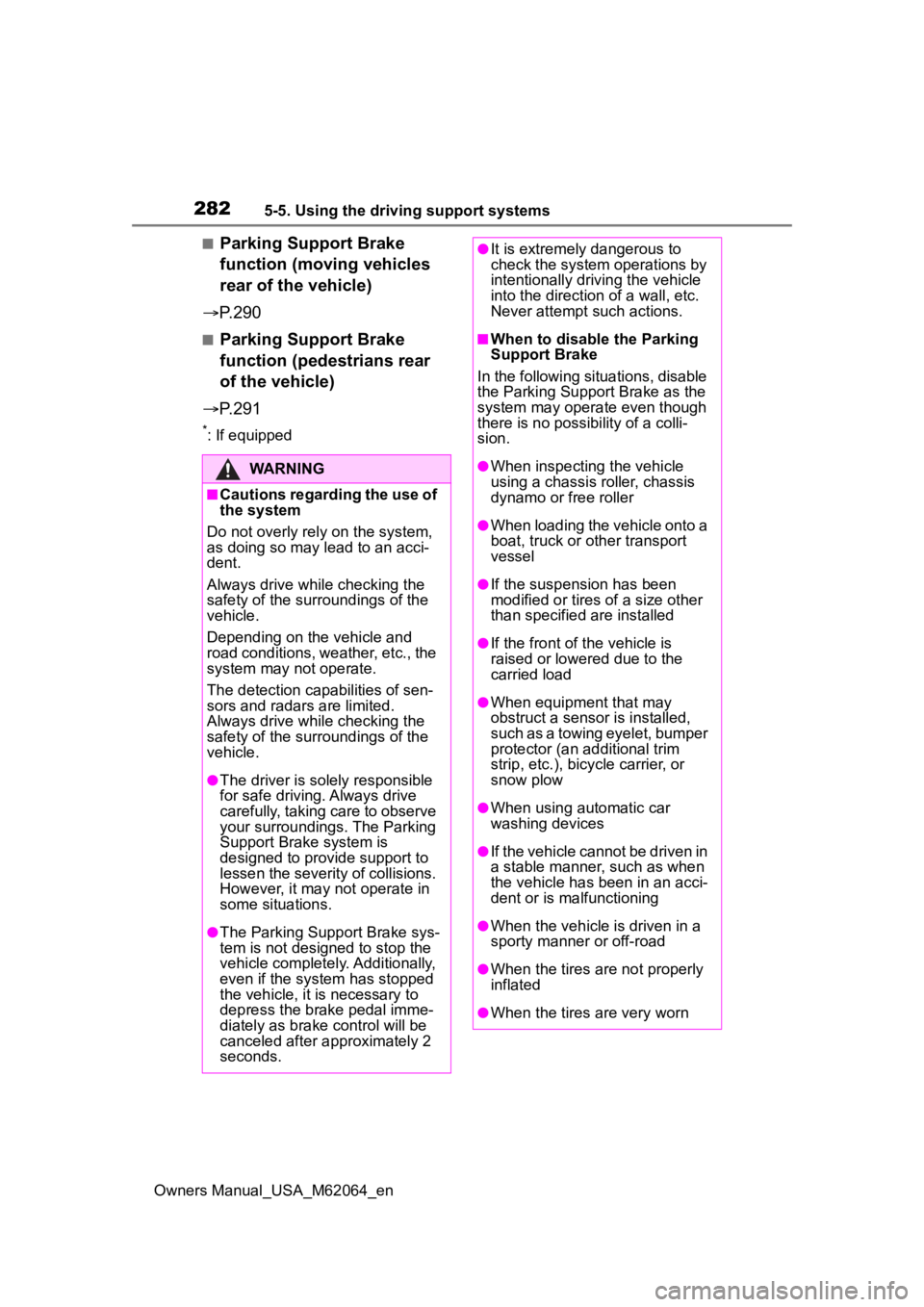
2825-5. Using the driving support systems
Owners Manual_USA_M62064_en
■Parking Support Brake
function (moving vehicles
rear of the vehicle)
P.290
■Parking Support Brake
function (pedestrians rear
of the vehicle)
P.291
*: If equipped
WARNING
■Cautions regarding the use of
the system
Do not overly rely on the system,
as doing so may lead to an acci-
dent.
Always drive while checking the
safety of the surroundings of the
vehicle.
Depending on the vehicle and
road conditions, weather, etc., the
system may not operate.
The detection capa bilities of sen-
sors and radars are limited.
Always drive while checking the
safety of the surroundings of the
vehicle.
●The driver is solely responsible
for safe driving. Always drive
carefully, taking care to observe
your surroundings. The Parking
Support Brake system is
designed to provide support to
lessen the severity of collisions.
However, it may not operate in
some situations.
●The Parking Support Brake sys-
tem is not designed to stop the
vehicle completely. Additionally,
even if the system has stopped
the vehicle, it is necessary to
depress the brake pedal imme-
diately as brake control will be
canceled after approximately 2
seconds.
●It is extremely dangerous to
check the system operations by
intentionally driving the vehicle
into the direction of a wall, etc.
Never attempt such actions.
■When to disable the Parking
Support Brake
In the following situations, disable
the Parking Suppor t Brake as the
system may opera te even though
there is no possibility of a colli-
sion.
●When inspecting the vehicle
using a chassis roller, chassis
dynamo or free roller
●When loading the vehicle onto a
boat, truck or other transport
vessel
●If the suspension has been
modified or tires of a size other
than specified are installed
●If the front of the vehicle is
raised or lowered due to the
carried load
●When equipment that may
obstruct a sensor is installed,
such as a towing eyelet, bumper
protector (an additional trim
strip, etc.), bicycle carrier, or
snow plow
●When using automatic car
washing devices
●If the vehicle cannot be driven in
a stable manner, such as when
the vehicle has been in an acci-
dent or is malfunctioning
●When the vehicle is driven in a
sporty manner or off-road
●When the tires are not properly
inflated
●When the tires are very worn
Page 286 of 572
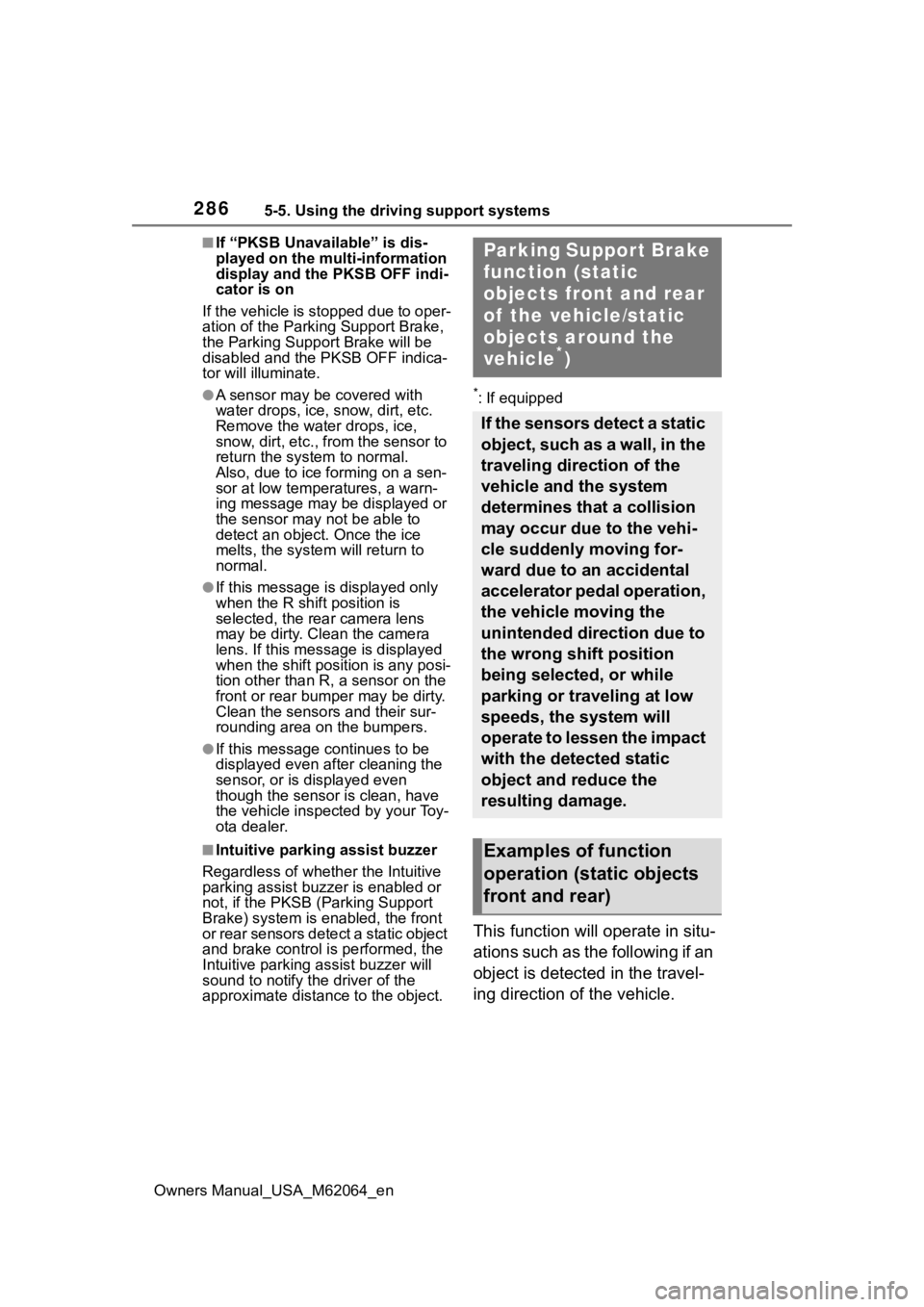
2865-5. Using the driving support systems
Owners Manual_USA_M62064_en
■If “PKSB Unavailable” is dis-
played on the multi-information
display and the PKSB OFF indi-
cator is on
If the vehicle is stopped due to oper-
ation of the Parki ng Support Brake,
the Parking Suppor t Brake will be
disabled and the PKSB OFF indica-
tor will illuminate.
●A sensor may be covered with
water drops, ice, snow, dirt, etc.
Remove the water drops, ice,
snow, dirt, etc., from the sensor to
return the system to normal.
Also, due to ice forming on a sen-
sor at low temperatures, a warn-
ing message may be displayed or
the sensor may n ot be able to
detect an object. Once the ice
melts, the system will return to
normal.
●If this message is displayed only
when the R shift position is
selected, the rear camera lens
may be dirty. Clean the camera
lens. If this message is displayed
when the shift position is any posi-
tion other than R, a sensor on the
front or rear bumper may be dirty.
Clean the sensors and their sur-
rounding area on the bumpers.
●If this message continues to be
displayed even after cleaning the
sensor, or is displayed even
though the sensor is clean, have
the vehicle inspected by your Toy-
ota dealer.
■Intuitive parking assist buzzer
Regardless of whether the Intuitive
parking assist buzzer is enabled or
not, if the PKSB ( Parking Support
Brake) system is enabled, the front
or rear sensors detect a static object
and brake control is performed, the
Intuitive parking assist buzzer will
sound to notify the driver of the
approximate distanc e to the object.
*: If equipped
This function will operate in situ-
ations such as the following if an
object is detected in the travel-
ing direction of the vehicle.
Parking Support Brake
function (static
objects front and rear
of the vehicle/static
objects around the
vehicle
*)
If the sensors detect a static
object, such as a wall, in the
traveling direction of the
vehicle and the system
determines that a collision
may occur due to the vehi-
cle suddenly moving for-
ward due to an accidental
accelerator pedal operation,
the vehicle moving the
unintended direction due to
the wrong shift position
being selected, or while
parking or traveling at low
speeds, the system will
operate to lessen the impact
with the detected static
object and reduce the
resulting damage.
Examples of function
operation (static objects
front and rear)
Page 288 of 572
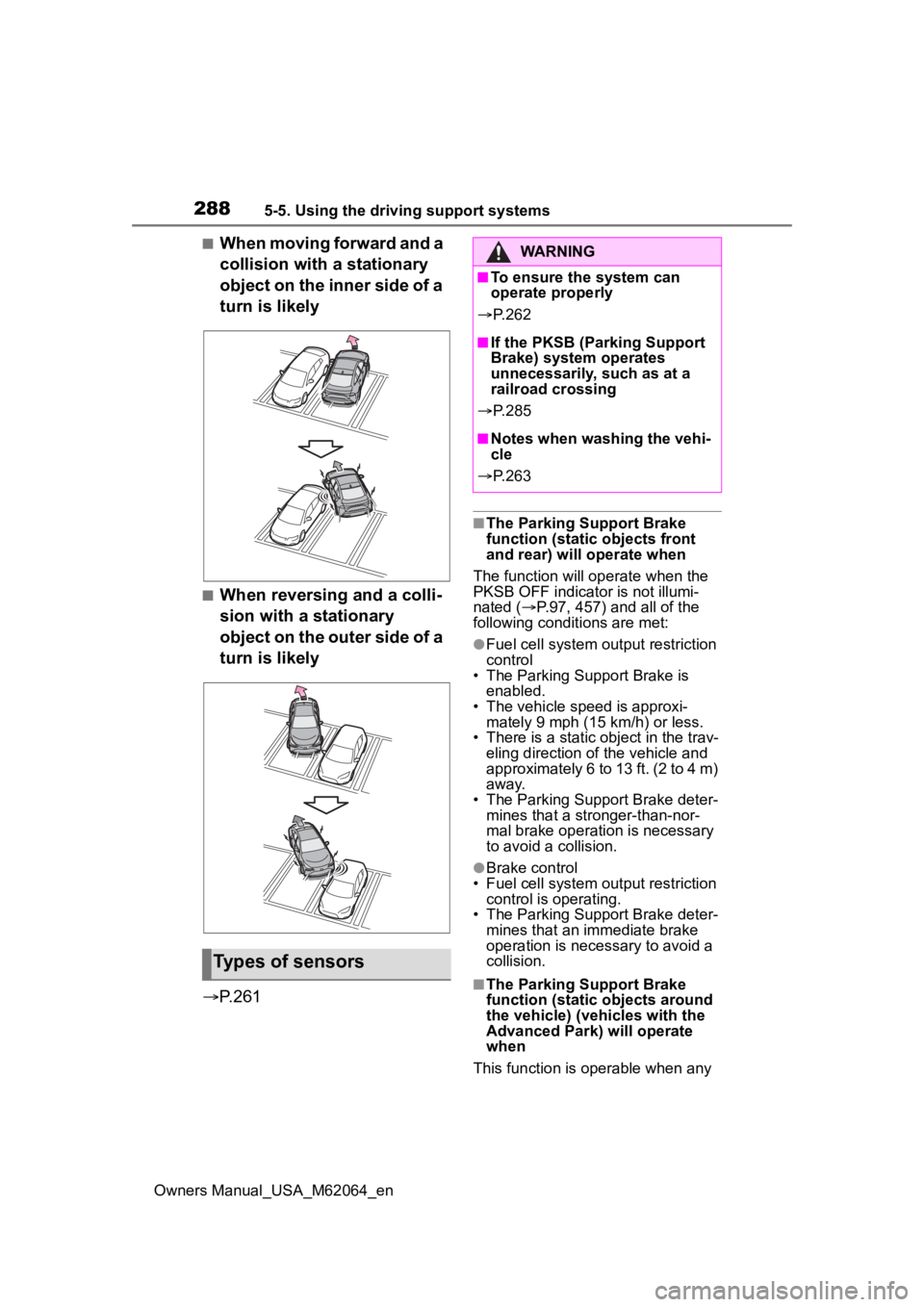
2885-5. Using the driving support systems
Owners Manual_USA_M62064_en
■When moving forward and a
collision with a stationary
object on the inner side of a
turn is likely
■When reversing and a colli-
sion with a stationary
object on the outer side of a
turn is likely
P.261
■The Parking Support Brake
function (static objects front
and rear) will operate when
The function will op erate when the
PKSB OFF indicator is not illumi-
nated ( P.97, 457) and all of the
following conditi ons are met:
●Fuel cell system output restriction
control
• The Parking Support Brake is enabled.
• The vehicle speed is approxi- mately 9 mph (15 km/h) or less.
• There is a static object in the trav-
eling direction of the vehicle and
approximately 6 to 13 ft. (2 to 4 m)
away.
• The Parking Support Brake deter- mines that a stronger-than-nor-
mal brake operation is necessary
to avoid a collision.
●Brake control
• Fuel cell system output restriction control is operating.
• The Parking Support Brake deter-
mines that an immediate brake
operation is necessary to avoid a
collision.
■The Parking Support Brake
function (static objects around
the vehicle) (ve hicles with the
Advanced Park) will operate
when
This function is operable when any
Types of sensors
WARNING
■To ensure the system can
operate properly
P. 2 6 2
■If the PKSB (Parking Support
Brake) system operates
unnecessarily, such as at a
railroad crossing
P. 2 8 5
■Notes when washing the vehi-
cle
P. 2 6 3
Page 289 of 572
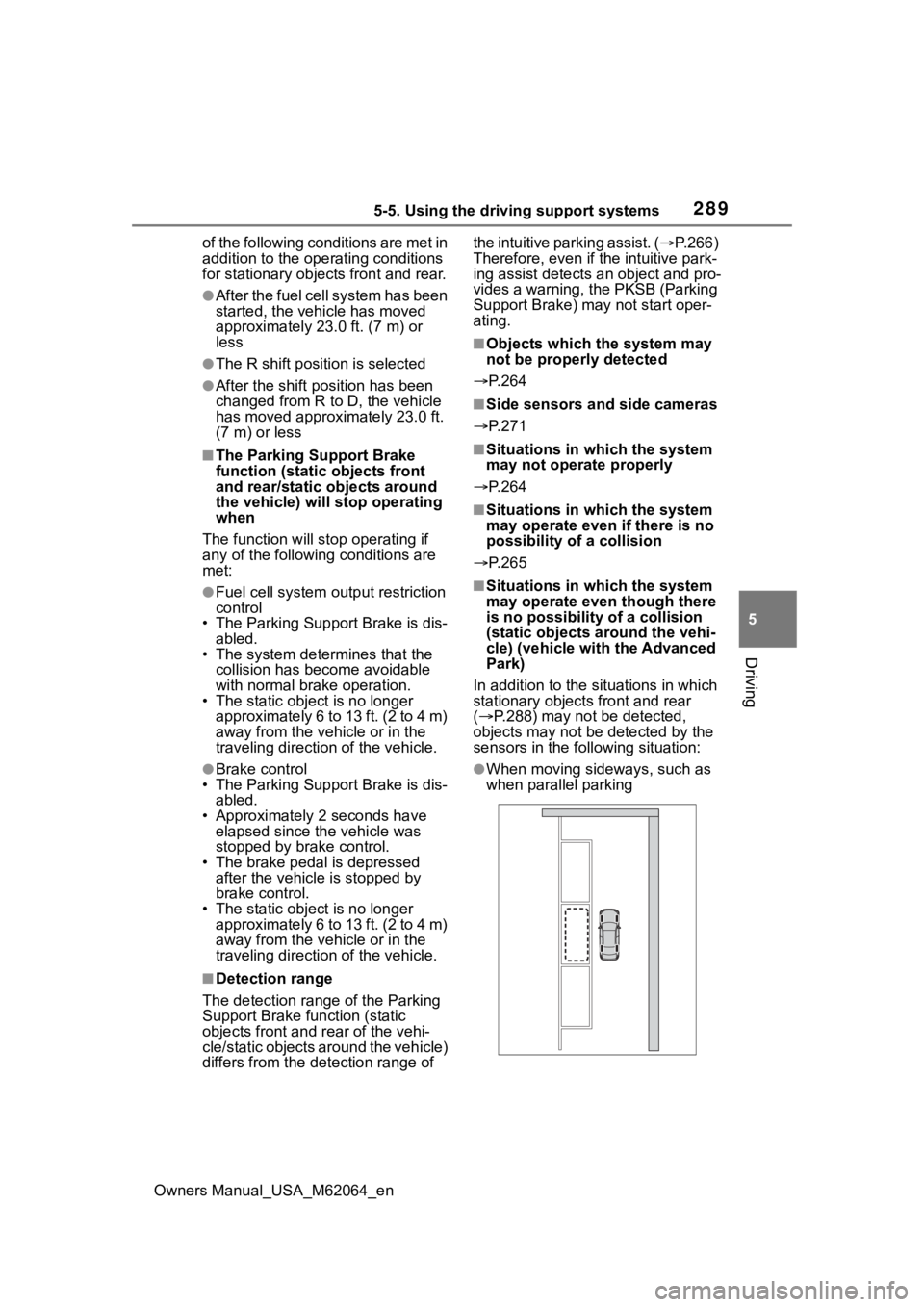
2895-5. Using the driving support systems
Owners Manual_USA_M62064_en
5
Driving
of the following conditions are met in
addition to the operating conditions
for stationary objects front and rear.
●After the fuel cell system has been
started, the vehicle has moved
approximately 23.0 ft. (7 m) or
less
●The R shift position is selected
●After the shift position has been
changed from R to D, the vehicle
has moved approximately 23.0 ft.
(7 m) or less
■The Parking Support Brake
function (static objects front
and rear/static objects around
the vehicle) will stop operating
when
The function will st op operating if
any of the following conditions are
met:
●Fuel cell system output restriction
control
• The Parking Support Brake is dis-
abled.
• The system determines that the collision has beco me avoidable
with normal brake operation.
• The static object is no longer approximately 6 to 13 ft. (2 to 4 m)
away from the vehicle or in the
traveling directi on of the vehicle.
●Brake control
• The Parking Support Brake is dis- abled.
• Approximately 2 seconds have elapsed since the vehicle was
stopped by brake control.
• The brake pedal is depressed after the vehicle is stopped by
brake control.
• The static object is no longer approximately 6 to 13 ft. (2 to 4 m)
away from the vehicle or in the
traveling directi on of the vehicle.
■Detection range
The detection range of the Parking
Support Brake function (static
objects front and r ear of the vehi-
cle/static objects around the vehicle)
differs from the detection range of the intuitive parking assist. (
P.266)
Therefore, even if the intuitive park-
ing assist detects an object and pro-
vides a warning, the PKSB (Parking
Support Brake) may not start oper-
ating.
■Objects which the system may
not be properly detected
P.264
■Side sensors and side cameras
P.271
■Situations in which the system
may not operate properly
P.264
■Situations in which the system
may operate even if there is no
possibility of a collision
P.265
■Situations in which the system
may operate even though there
is no possibility of a collision
(static objects around the vehi-
cle) (vehicle with the Advanced
Park)
In addition to the situations in which
stationary objects front and rear
( P.288) may not be detected,
objects may not be detected by the
sensors in the fo llowing situation:
●When moving sideways, such as
when parallel parking
Page 290 of 572
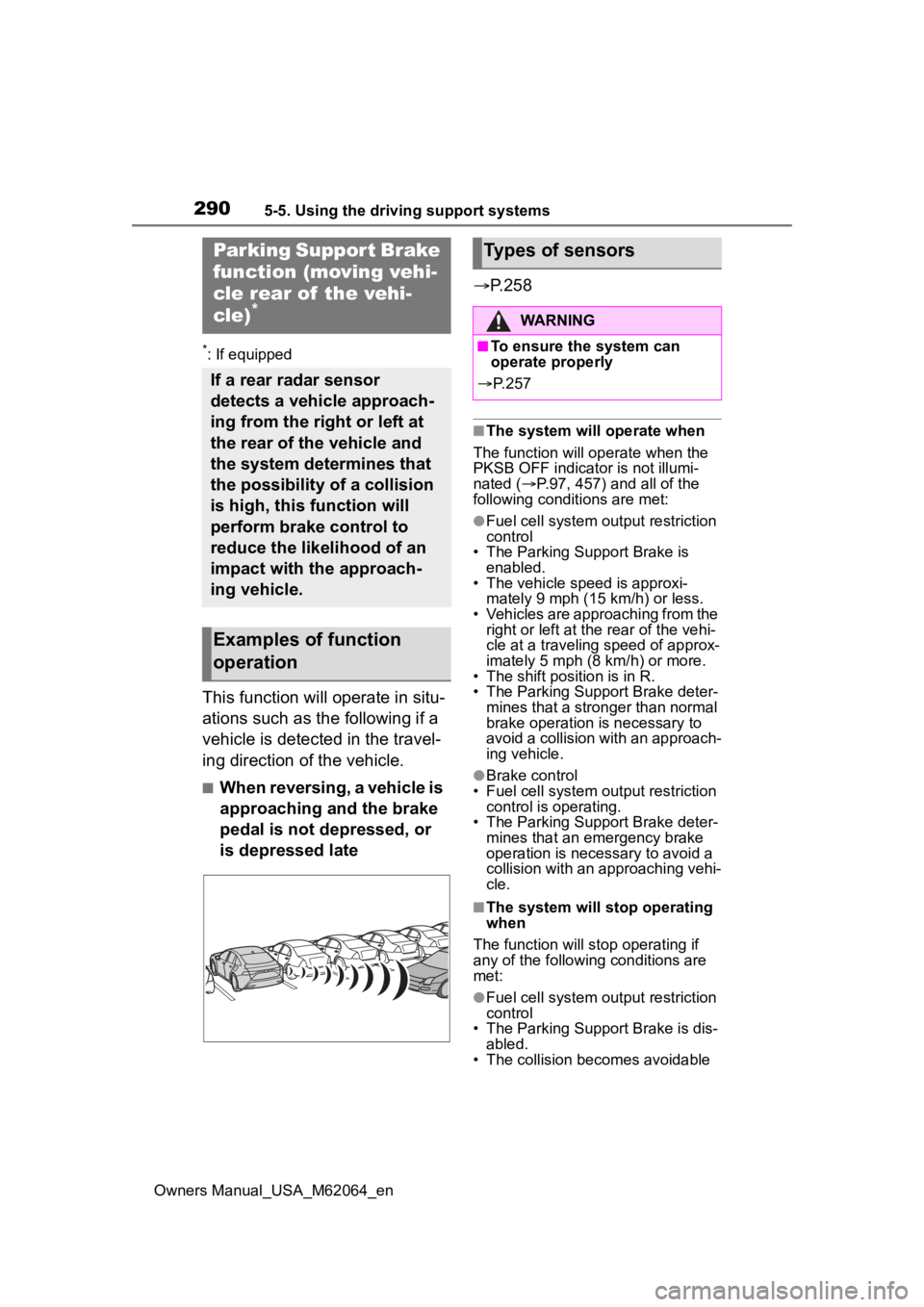
2905-5. Using the driving support systems
Owners Manual_USA_M62064_en
*: If equipped
This function will operate in situ-
ations such as the following if a
vehicle is detected in the travel-
ing direction of the vehicle.
■When reversing, a vehicle is
approaching and the brake
pedal is not depressed, or
is depressed late
P.258
■The system will operate when
The function will op erate when the
PKSB OFF indicator is not illumi-
nated ( P.97, 457) and all of the
following conditi ons are met:
●Fuel cell system output restriction
control
• The Parking Support Brake is enabled.
• The vehicle speed is approxi- mately 9 mph (15 km/h) or less.
• Vehicles are approaching from the
right or left at the rear of the vehi-
cle at a traveling speed of approx-
imately 5 mph (8 km/h) or more.
• The shift position is in R.
• The Parking Support Brake deter- mines that a stronger than normal
brake operation is necessary to
avoid a collision with an approach-
ing vehicle.
●Brake control
• Fuel cell system output restriction
control is operating.
• The Parking Support Brake deter- mines that an emergency brake
operation is necessary to avoid a
collision with an approaching vehi-
cle.
■The system will stop operating
when
The function will stop operating if
any of the following conditions are
met:
●Fuel cell system output restriction
control
• The Parking Support Brake is dis-
abled.
• The collision becomes avoidable
Parking Suppor t Brake
function (moving vehi-
cle rear of the vehi-
cle)
*
If a rear radar sensor
detects a vehicle approach-
ing from the right or left at
the rear of the vehicle and
the system determines that
the possibility of a collision
is high, this function will
perform brake control to
reduce the likelihood of an
impact with the approach-
ing vehicle.
Examples of function
operation
Types of sensors
WARNING
■To ensure the system can
operate properly
P. 2 5 7
Page 291 of 572
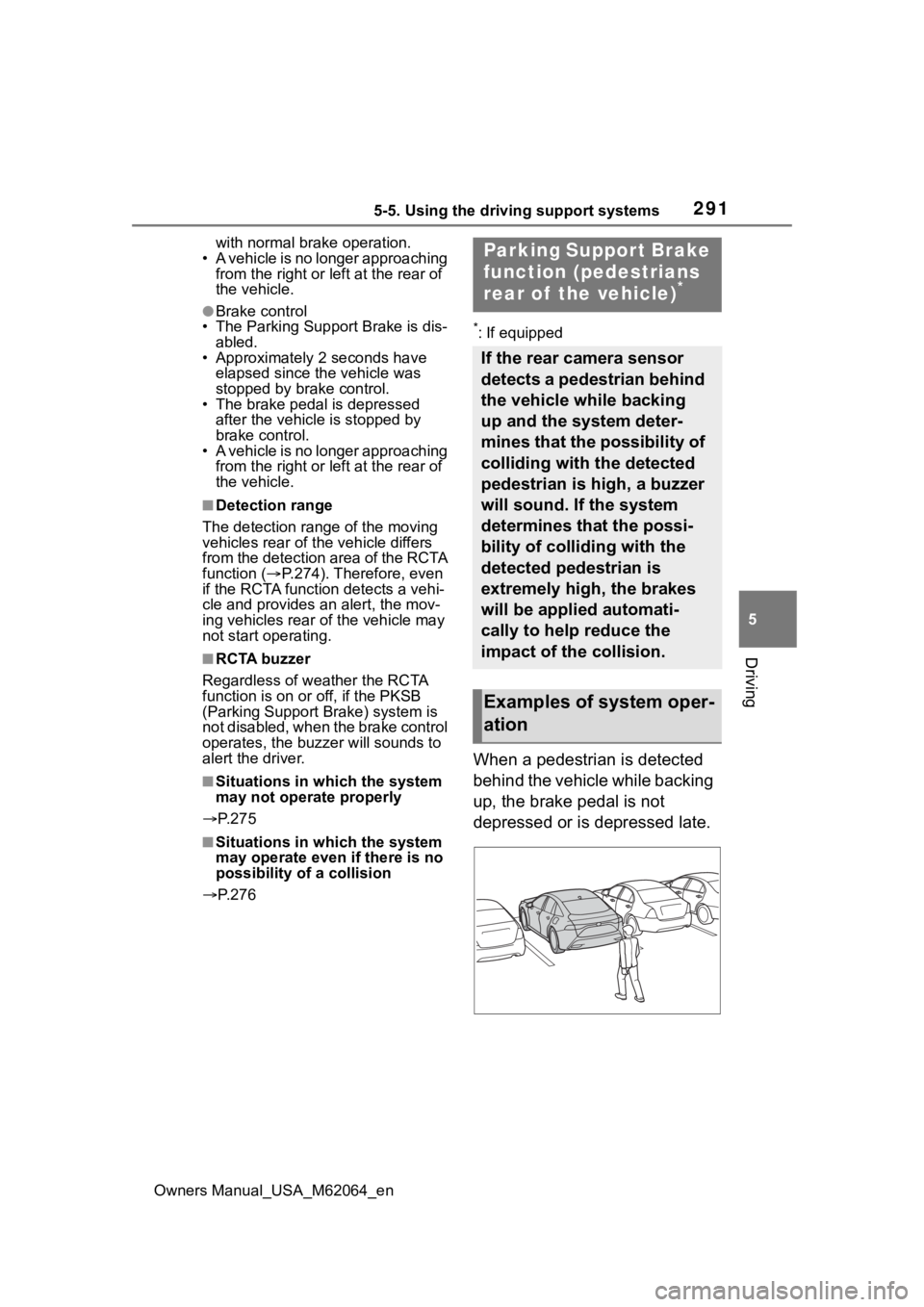
2915-5. Using the driving support systems
Owners Manual_USA_M62064_en
5
Driving
with normal brake operation.
• A vehicle is no longer approaching from the right or left at the rear of
the vehicle.
●Brake control
• The Parking Support Brake is dis- abled.
• Approximately 2 seconds have
elapsed since the vehicle was
stopped by brake control.
• The brake pedal is depressed
after the vehicle is stopped by
brake control.
• A vehicle is no longer approaching
from the right or left at the rear of
the vehicle.
■Detection range
The detection range of the moving
vehicles rear of the vehicle differs
from the detection area of the RCTA
function ( P.274). Therefore, even
if the RCTA function detects a vehi-
cle and provides an alert, the mov-
ing vehicles rear of the vehicle may
not start operating.
■RCTA buzzer
Regardless of weather the RCTA
function is on o r off, if the PKSB
(Parking Support Brake) system is
not disabled, when the brake control
operates, the buzze r will sounds to
alert the driver.
■Situations in which the system
may not operate properly
P. 2 7 5
■Situations in which the system
may operate even if there is no
possibility of a collision
P. 2 7 6
*: If equipped
When a pedestrian is detected
behind the vehicle while backing
up, the brake pedal is not
depressed or is depressed late.
Parking Support Brake
function (pedestrians
rear of the vehicle)
*
If the rear camera sensor
detects a pedestrian behind
the vehicle while backing
up and the system deter-
mines that the possibility of
colliding with the detected
pedestrian is high, a buzzer
will sound. If the system
determines that the possi-
bility of colliding with the
detected pedestrian is
extremely high, the brakes
will be applied automati-
cally to help reduce the
impact of the collision.
Examples of system oper-
ation
Page 292 of 572
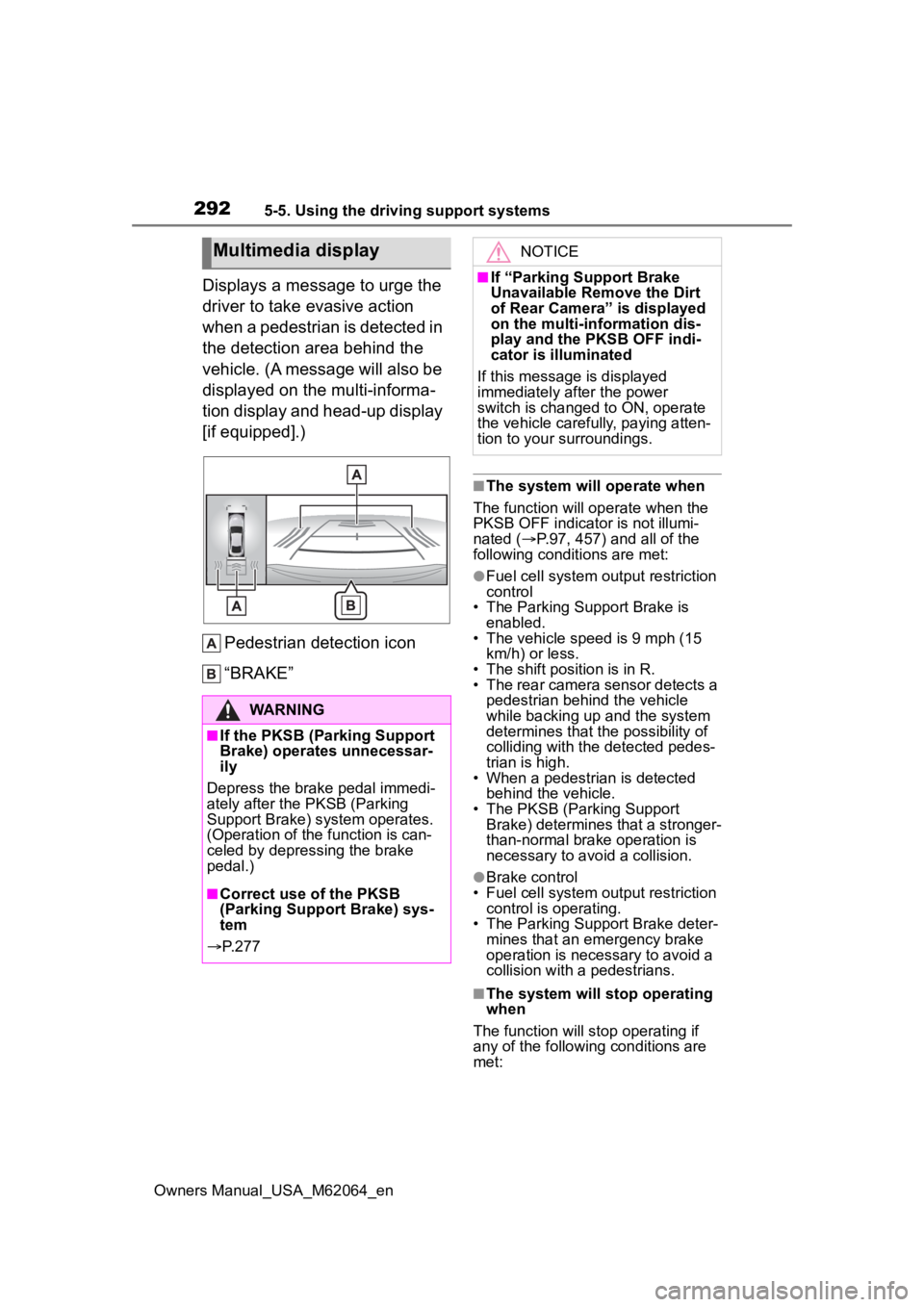
2925-5. Using the driving support systems
Owners Manual_USA_M62064_en
Displays a message to urge the
driver to take evasive action
when a pedestrian is detected in
the detection area behind the
vehicle. (A message will also be
displayed on the multi-informa-
tion display and head-up display
[if equipped].)Pedestrian detection icon
“BRAKE”
■The system will operate when
The function will op erate when the
PKSB OFF indicator is not illumi-
nated ( P.97, 457) and all of the
following conditi ons are met:
●Fuel cell system output restriction
control
• The Parking Support Brake is
enabled.
• The vehicle speed is 9 mph (15 km/h) or less.
• The shift position is in R.
• The rear camera sensor detects a pedestrian behind the vehicle
while backing up and the system
determines that the possibility of
colliding with the detected pedes-
trian is high.
• When a pedestrian is detected behind the vehicle.
• The PKSB (Parking Support Brake) determines that a stronger-
than-normal brake operation is
necessary to avoid a collision.
●Brake control
• Fuel cell system output restriction control is operating.
• The Parking Support Brake deter-
mines that an emergency brake
operation is necessary to avoid a
collision with a pedestrians.
■The system will stop operating
when
The function will stop operating if
any of the following conditions are
met:
Multimedia display
WARNING
■If the PKSB (Parking Support
Brake) operates unnecessar-
ily
Depress the brake pedal immedi-
ately after the PKSB (Parking
Support Brake) s ystem operates.
(Operation of the function is can-
celed by depressing the brake
pedal.)
■Correct use of the PKSB
(Parking Support Brake) sys-
tem
P. 2 7 7
NOTICE
■If “Parking Support Brake
Unavailable Remove the Dirt
of Rear Camera” is displayed
on the multi-information dis-
play and the PKSB OFF indi-
cator is illuminated
If this message is displayed
immediately after the power
switch is changed to ON, operate
the vehicle carefully, paying atten-
tion to your surroundings.
Page 297 of 572
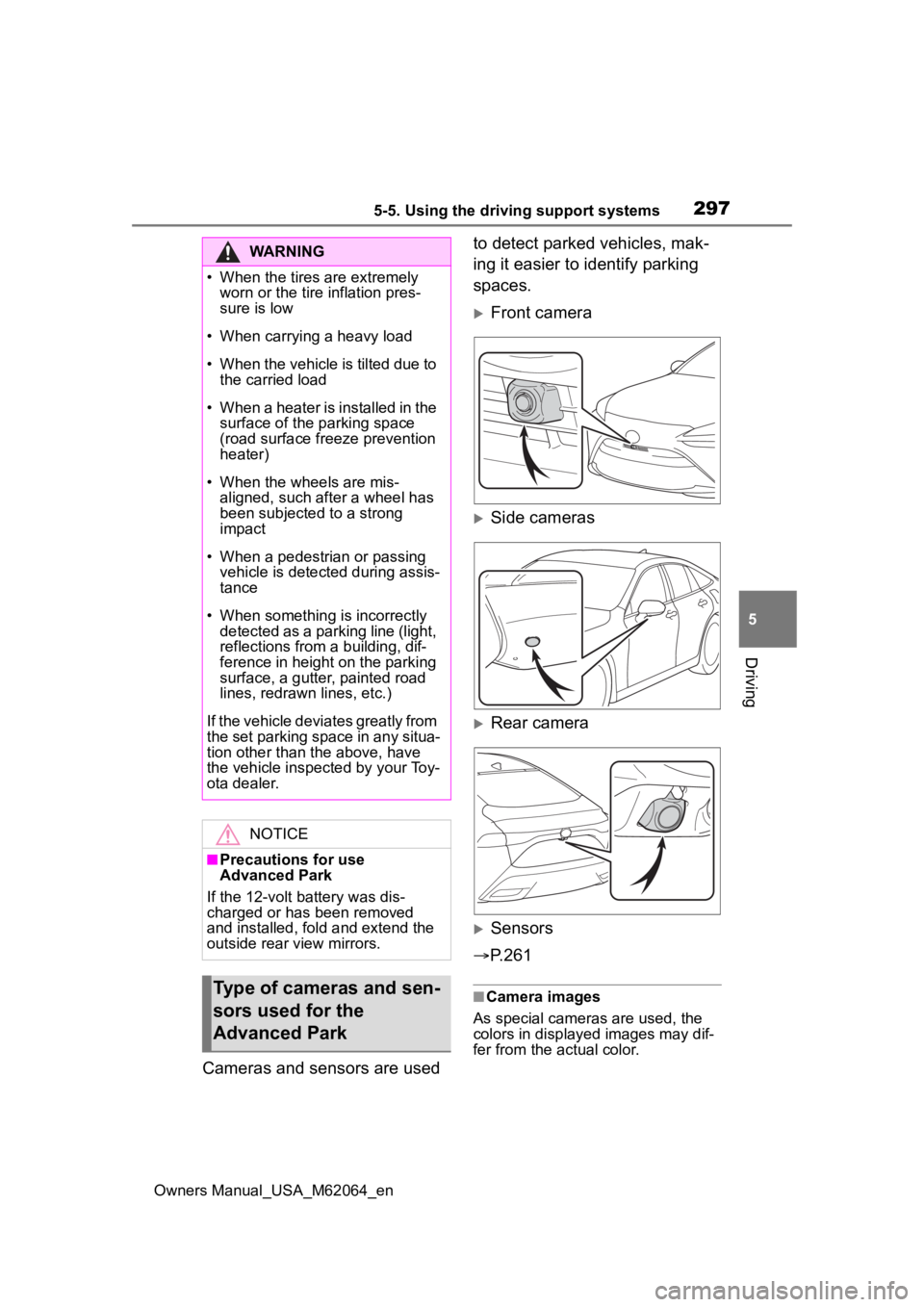
2975-5. Using the driving support systems
Owners Manual_USA_M62064_en
5
Driving
Cameras and sensors are used to detect parked vehicles, mak-
ing it easier to identify parking
spaces.
Front camera
Side cameras
Rear camera
Sensors
P.261
■Camera images
As special cameras are used, the
colors in displaye d images may dif-
fer from the actual color.
WARNING
�
Page 298 of 572

2985-5. Using the driving support systems
Owners Manual_USA_M62064_en
■Precautions for use
For details on the following, refer to
“Panoramic view monitor” of “Pan-
oramic view monitor functions” in
the “MULTIMEDIA OWNER’S MAN-
UAL”.
●Displayable range of the screens
●Cameras
●Differences between displayed
images and the actual road
●Differences between displayed
images and the actual objects
■Detection range of the cameras
and sensors
●If a parked vehicle is behind the
target parking space and the dis-
tance between it a nd the vehicle
becomes far, it may no longer be
able to be detected. Depending on
shape or conditi on of a parked
vehicle, the detection range may
become short or the vehicle may
not be detected.
●Objects other than parked vehi-
cles, such as columns, walls, etc.,
may not be detect ed. Also, if they
are detected, they may cause the
target parking space to be mis-
aligned.
■Situations in which parking
space lines may not be recog-
nized properly
●In situations such as the following,
parking space lines on the road
surface may not be detected:
• When the parking space does not
use lines (parking space boundar-
ies are marked with rope, blocks,
etc.)
• When the parking space lines are
faded or dirty, making them
unclear
• When the road surface is bright,
such as concrete, and the contrast
between it and t he white parking
space lines is small
• When the parking space lines are
any color other than yellow or
white
• When the area surrounding the parking space is dark, such as at
night, in an underground parking
lot, parking garage, etc.
• When it is raining or has rained and the road surface is wet and
reflective or there are puddles
• When the sun is shining directly into a camera, such as in the early
morning or evening
• When the parking space is cov- ered with snow or de-icing agent
• When there marks from repairs or
other marks on the road surface,
or there is a traffic bollard, or other
object on the road surface
• When the color or brightness of the road surface is uneven
• When a camera has been
splashed by hot or cold water and
the lens has fogged up
• When the appearance of the park-
ing space is affected by the
shadow of the vehicle or trees
• When a camera lens is dirty or
covered with wa ter droplets
●In situations such as the following,
the target parking space may not
be recognized correctly:
• When there marks from repairs or
other marks on the road surface,
or there is a parking block, traffic
bollard, or other object on the road
surface
• When it is raining or has rained and the road surface is wet and
reflective or there are puddles
• When the area around the vehicle is dark or backlit
• When the color or brightness of the road surface is uneven
• When the parking space is on a
slope
• When there are diagonal lines (access aisle) nea r the parking
space
• When the appearance of the park- ing space is affected by the
shadow of a parked vehicle (such
as shadows from the grille, side
step, etc.)
• When accessories which obstruct
the view of the camera are
installed
• When the parking space lines are
Page 299 of 572
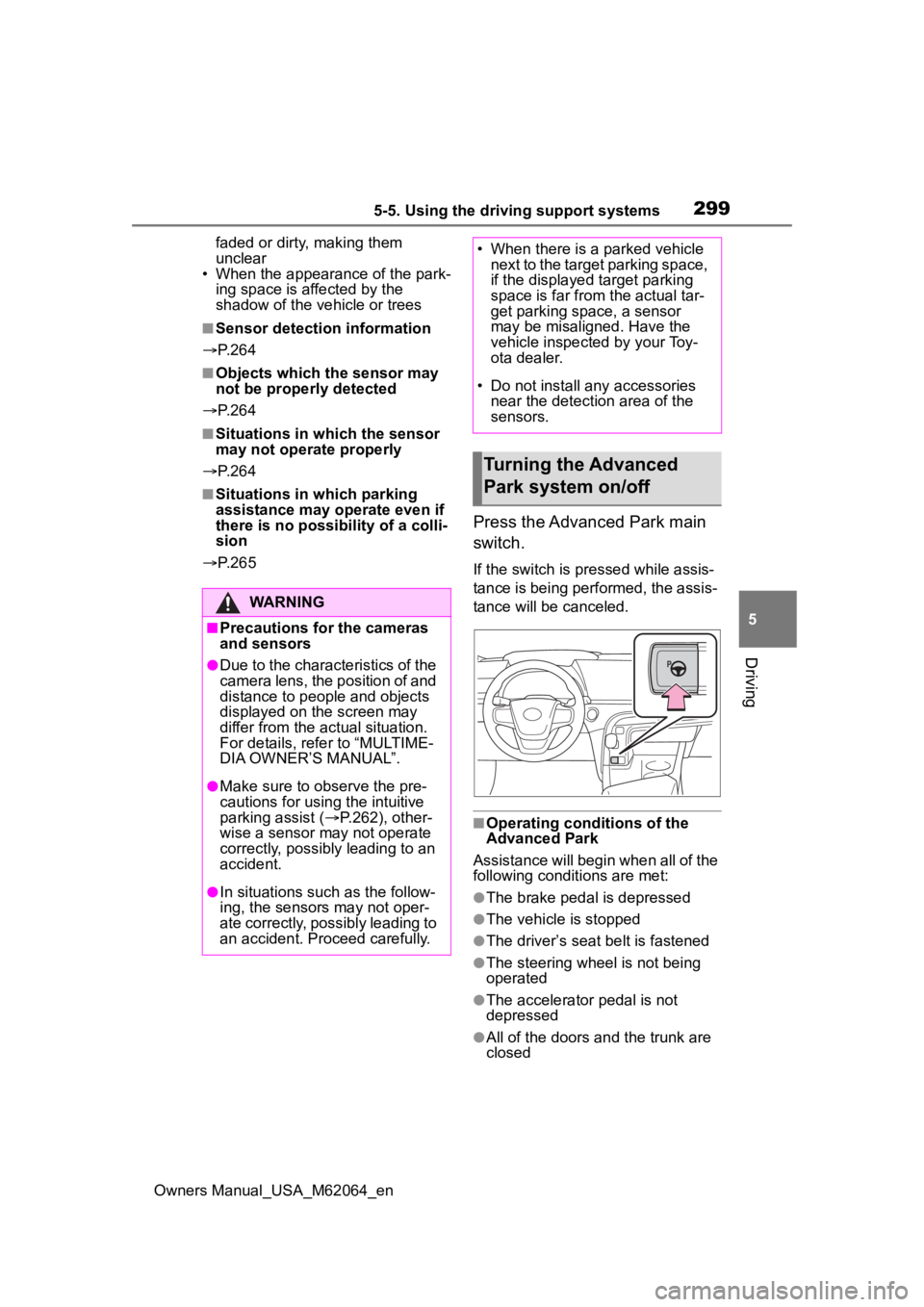
2995-5. Using the driving support systems
Owners Manual_USA_M62064_en
5
Driving
faded or dirty, making them
unclear
• When the appeara nce of the park-
ing space is affected by the
shadow of the vehicle or trees
■Sensor detection information
P. 2 6 4
■Objects which the sensor may
not be properly detected
P. 2 6 4
■Situations in which the sensor
may not operate properly
P. 2 6 4
■Situations in which parking
assistance may operate even if
there is no possibility of a colli-
sion
P. 2 6 5
Press the Advanced Park main
switch.
If the switch is pressed while assis-
tance is being performed, the assis-
tance will be canceled.
■Operating conditions of the
Advanced Park
Assistance will begin when all of the
following conditi ons are met:
●The brake pedal is depressed
●The vehicle is stopped
●The driver’s seat belt is fastened
●The steering wheel is not being
operated
●The accelerator pedal is not
depressed
●All of the doors a nd the trunk are
closed
WARNING
■Precautions for the cameras
and sensors
●Due to the characteristics of the
camera lens, the position of and
distance to people and objects
displayed on the screen may
differ from the actual situation.
For details, refer to “MULTIME-
DIA OWNER’S MANUAL”.
●Make sure to observe the pre-
cautions for using the intuitive
parking assist ( P.262), other-
wise a sensor ma y not operate
correctly, possibly leading to an
accident.
●In situations such as the follow-
ing, the sensors may not oper-
ate correctly, possibly leading to
an accident. Proceed carefully.
• When there is a parked vehicle next to the target parking space,
if the displayed target parking
space is far from the actual tar-
get parking space, a sensor
may be misaligned. Have the
vehicle inspected by your Toy-
ota dealer.
• Do not install any accessories near the detection area of the
sensors.
Turning the Advanced
Park system on/off